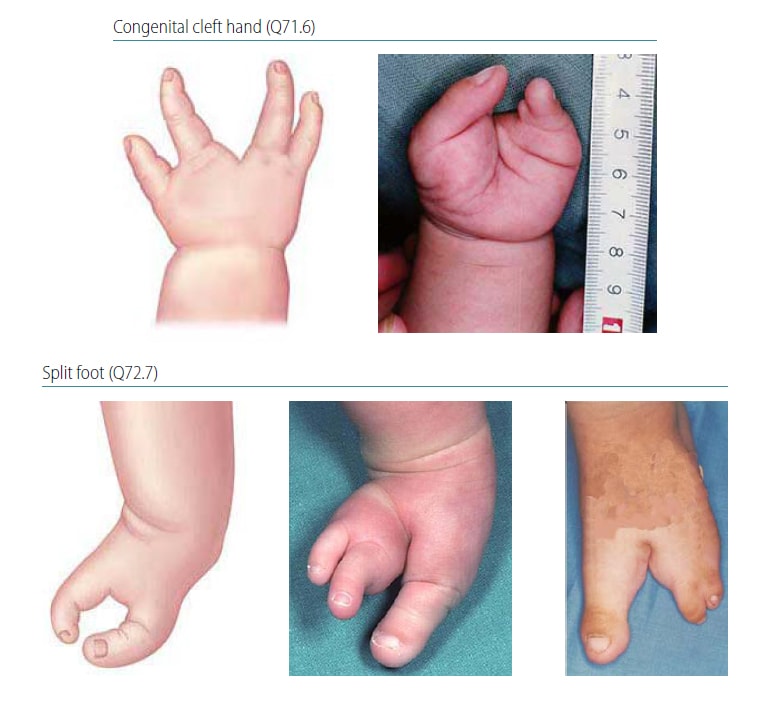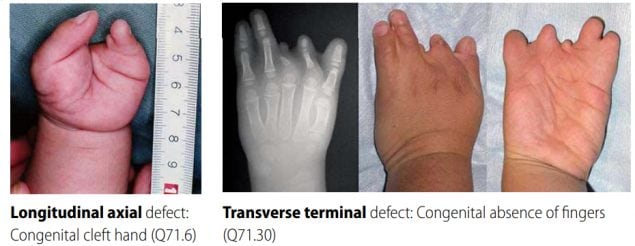4.9h Limb Deficiency: Longitudinal Axial Limb Deficiency – Split Hand and Foot (Q71.6, Q72.7)
The longitudinal axial or split hand/split foot deficiency is characterized by a deficiency of the central digits/toes often involving the associated carpal/tarsal bones, leading to the typical external appearance that gave rise to the name split hand or split foot (see Fig. 4.41).
Fig. 4.41. Split hand and foot

Relevant ICD-10 codes
Q71.6 Congenital cleft hand
Q72.7 Split foot
Note: Avoid using the generic Q71, Q72 or Q73 codes for split hand and split foot. These generic codes include other limb reduction defects.
Diagnosis
Prenatal. Split hand and split foot might be diagnosed or strongly suspected prenatally. However, they can be missed. Moreover, the distinction from other limb deficiencies is difficult and error-prone. For this reason, a prenatal diagnosis should always be confirmed postnatally.
When this is not possible (e.g. termination of pregnancy or unexamined fetal death), the programme should have criteria in place to determine whether to accept or not accept a case based solely on prenatal data.
Postnatal. The newborn examination can identify the typical external appearance of this condition, although on occasion there is confusion with terminal transverse deficiencies involving the middle fingers. An accurate and complete diagnosis requires a detailed physical examination aided by radiography to characterize completely the bony anatomy of the axial (central) segments of the hands and feet.
Clinical and epidemiologic notes
Note that older terms such as ectrodactyly and lobster claw hands have been used in the past but should be avoided, as these are either imprecise or pejorative.
Cases of split hand or split foot can occur with syndactyly and hypoplasia of some of the remaining digits. The most severe form of split hand or split foot is monodactyly, where the hand or foot only has a single digit.
This condition can involve only the hands, only the feet, or both the hands and feet. Hands are affected much more frequently than feet. Most cases are unilateral, with the right side more commonly affected.
Split hand and split foot might occur with deficiency of the adjacent long bones of the limbs.
Split hand/split foot is part of a large group of syndromes due to one of several single-gene conditions or genomic rearrangements, some of which involve other organ systems. Examples include the EEC syndromes (ectrodactyly, ectodermal dysplasia, cleft lip/palate), and the limb-mammary syndrome (split hand split foot, absence of breast tissue, cleft palate).
The prevalence of axial limb deficiencies is around 0.15 per 10 000 births.
Inclusions
Q71.6 Congenital cleft hand
Q72.7 Split foot
Exclusions
Q68.10 Clinodactyly
Q70 Syndactyly
Q71.3 Congenital absence of hand and finger(s)
Q71.30 Congenital absence of finger(s)
Q71.31 Absence or hypoplasia of thumb (other digits intact)
Q72.3 Congenital absence of foot and toe(s)
Q72.30 Congenital absence or hypoplasia of toe(s) with remainder of foot intact
Q72.31 Absence or hypoplasia of first toe with other digits present
Q74.80 Brachydactyly
Checklist for high-quality reporting
| Split Hand and Foot – Documentation Checklist |
Describe in detail, including:
|
Suggested data quality indicators
| Category | Suggested Practices and Quality indicators |
| Description and documentation | Review sample for documentation of key descriptors:
|
| Coding |
|
| Clinical classification |
|
| Prevalence |
|
| Key visuals | Distinguishing longitudinal axial defects from transverse terminal defects of hand/foot (side-by-side comparison):
 |